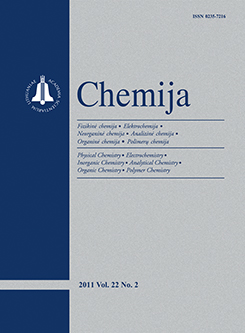Chemija / Chemistry
WHAT?
 ISSN 0235-7216 ISSN 2424-4538 (online) |
2012 m. Nr. 3 Changes in the chemical composition of the essential oil of sweet basil (Ocimum basilicum L.) depending on the plant growth stage
Genetic and environmental factors as well as plant ontogeny have a determining effect on the yield and quality of Ocimum basilicum L. volatile oil; ontogenetic variation is particularly important, since it largely determines the proper time for harvesting raw material as well as its chemical composition and activity. The aim of the present study was to determine relationships between the content and chemical composition of the essential oil of the sweet basil herb and the plant growth stage as well as to evaluate the usefulness of two basil cultivars for industry. The present experiment was conducted in a greenhouse during the period from February to May in the years 2008–2010. The basil herb was harvested at three growth stages: vegetative stage, flower bud stage, and full flowering, while the amount of essential oil (by hydrodistillation) and its composition (GC-MS and GC-FID) were evaluated in two cultivars: ‘Kasia’ and ‘Wala’. The essential oil content in the herb of the basil cultivars under study was high (0.83% in the cultivar ‘Kasia’ and 0.75% in cv. ‘Wala’) and it increased with plant development. The studied essential oils were characterized by the presence of 63 compounds, among which linalool was the dominant one. The concentration of linalool was from 55.4% to 69.8%, depending on the cultivar and plant growth stage. The oil extracted at the flower bud stage was characterized by the highest proportion of linalool (in both cultivars) and of 1,8-cineole (only in the cultivar ‘Kasia’). The concentration of methyl chavicol and methyl eugenol in the oil decreased together with the development of the basil plants studied, similarly to the concentration of limonene, α-humulene, cis-muurola-4(14),5-diene, and transcalamene.
Keywords: asilici herba, basil cultivars, ontogenesis, linalool, 1,8-cineole, methyl chavicol |
Issues:
2017 - Vol.28 No. 1, No. 2, No. 3, No. 4 2016 - Vol.27 No. 1, No. 2, No. 3, No. 4 2015 - Vol.26 No. 1, No. 2, No. 3, No. 4 2014 - Vol.25 No. 1, No. 2, No. 3, No. 4 2013 - Vol.24 No. 1, No. 2, No. 3, No. 4 2012 - Vol.23 No. 1, No. 2, No. 3, No. 4 2011 - Vol.22 No. 1, No. 2, No. 3, No. 4 2010 - Vol.21 No. 1, No. 2-4 2009 - Vol.20 No. 1, No. 2, No. 3, No. 4 2008 - Vol.19 No. 1, No. 2, No. 3-4 2007 - Vol.18 No. 1, No. 2, No. 3, No. 4 2006 - Vol.17 No. 1, No. 2-3, No. 4 2005 - Vol.16 No. 1, No. 2, No. 3-4 2004 - Vol.15 No. 1, No. 2, No. 3, No. 4 2003 - Vol.14 No. 1, No. 2, No. 3, No. 4 2002 - Vol.13 No. 1, No. 2, No. 3, No. 4 2001 - Vol.12 No. 1, No. 2, No. 3, No. 4 |